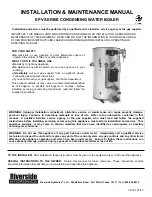
EPV SERIES CONDENSING WATER BOILER
34-501 07/13
13
8. Check all connections within the control cabinet. A loose connection could cause intermittent shutdowns.
9. Some burners will use direct spark ignition. They may use a single gas pressure regulator and gas valve or
multiple valves and regulators. On a call for heat, the motor starts, gas primary control is energized, the air
vent damper opens and after a short delay (pre-purge), the gas valve(s) opens and ignition should occur.
10.
NOTE:
Do not tamper with or readjust program dipswitch settings. This will cause the control to become
inoperable. Damage resulting from tampering will be excluded from coverage under the warranty of this unit.
11. Connect a test meter to the control for reading the flame response signal.
12.
NOTE
: Some controls read the flame signal in micro amps and some in volts DC. The M series control has
two terminals marked for reading volts in DC.
13.
CAUTION
: Be sure the tank is filled with water. Dry firing can destroy the boiler.
14. Check the gas pressure before start-up, using a U-tube manometer or a 0 to 28" W.C. pressure gauge for
inlet gas pressure. (This is the pressure measured before all components in the gas train.) The manometer
must stay connected throughout the testing, as the inlet pressure must be monitored during the firing of the
burner. Record static pressure; it must not exceed 14" W.C. Pressures above this could cause damage to the
diaphragm in the gas valve or pressure regulator.
15. Connect a manometer to the manifold test port at the shutoff valve closest to the burner. Turn off main gas
shutoff valve. Turn unit on using the rocker switch on the side of the control enclosure assembly. If the
operating control switches are closed, the burner blower should come on and pre-purge begins.
16. If nothing happens, check the control to be sure it is not in the tripped position and reset it by pushing the
flame safeguard reset button. The burner should pre-purge at least thirty seconds.
17. When the blower motor starts, the air damper will open and the airflow proving light on the MEC120 should be
on. This indicates a positive airflow condition. If the air proving light is not on, check the air-proving switch for
operation. To adjust the air-proving switch, turn the adjustment screw counter-clockwise until the air proving
light comes on, then turn the screw one turn counter-clockwise. If the gas valves open and close intermittently
during normal operation, turn screw one half turn counter-clockwise until this condition ceases. This
procedure should be followed with every burner.
This section is for single-stage and two-stage firing
:
After purging is complete, terminal 3 on the flame control energizes the pilot valve and terminal 4 energizes
the ignition transformer. The pilot is then established. The VDC reading on the meter should read a steady 6-
10 VDC; 6 VDC is the minimum flame signal for it to operate reliably. If the pilot fails to light during the initial
period, it is probably due to air in the line. The control will lock out and require reset.
Once the flame is established, the ignition transformer will de-energize and terminal 5 will energize the main
valve. At this point the boiler is operating at maximum firing rate (high fire). In order to insure the boiler is
operating at the rated input, it is necessary to check the manifold gas pressure (measured at the pressure tap
on the gas valve closest to burner). The manifold gas pressure should be adjusted at main gas regulator to
the factory recommended pressure shown on tag attached to gas train. Do not screw the adjusting nut of the
regulator in beyond point where no further increase in manifold pressure is noted. While firing, check the gas
pressure at the inlet of the gas train. The minimum supply pressure requirement on the Power VT boiler is
4.5" W.C. supply unless otherwise specified on the data plate. It should be a minimum of that shown above
with the boiler running at high fire. This is recorded as inlet flow pressure. It is important incoming pressure
does not fall below this minimum or nuisance control lockouts could occur.






















